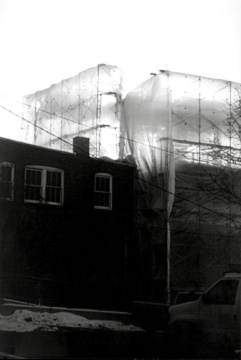Construction Ghosts, William V. Suchmann
 Construction Ghosts
Construction GhostsPhotographer, William V. Suchmann
©2005
Finding the photographic work of William Suchmann is much like an archeological dig. He is very private He has shunned galleries.
A builder, a brick and stone mason, by choice of trade, his origins are not that humble and have always been connected to architecture and original ways of seeing.
He was born in New York City in 1949 and grew up under the impressions of the high powered New York advertising world, where his father was an industry leader.
His father, an art director for Omnibus, a predecessor of Sesame Street, was also the talent that originated the Mercury Cougar Campaign, (The Sign of the Cat), for Ford, in the automotive industry. He constantly brought Wm onto his sets to expose him to the creative and intellectual elite of the time. As a boy, he was introduced to such thinkers as Albert Einstein and Dr. Seuss, who personally created a letter for him in his book On Beyond Zebra.
In the late sixties, William attended Silvermine College of Art, a cutting edge art college and creative thinktank outside of New York, in New Canaan, Connecticut, that attracted a unique and potent student and faculty body.
After college, William worked in various fields, but primarily kept his focus in the film industry, working on projects that led him to Hollywood and New Mexico, but mostly New York. There he apprenticed for a number of years under Wally Welebit, who produced many commercials and industrial films as well as one feature film and who was, possibly best remembered as a ski industry film pioneer. In the late seventies, Wm left New York for New England where, continuing his passion for building, he learned the craft of brick and stone masonry.
Throughout these decades, he has kept a camera at his side, taking pictures, developing his vision for photography and his craft.
Much of Williams eye, in his cityscapes is attracted to the structural scape, the poetry of construction and deconstruction. His compositions focus in on the darker and more abstract visions of photography, noting its shadows and crevices, as well as the profound in the obvious.
You may have to look awhile to find what he saw. But when you leave, these photographs of the city, more often than not, leave the impressions he exposes of the haunted traces of an infrastructure that is evolving, the backdrop of decay against the framework of rising progress.
He pleases his own eye and does not care so much if we can follow. Yet he is easy, like a cat who knows his turf and he prowls it with ease. We can tag along with him if we wish.
We have found it an interesting and complex path we trail behind and hurry to keep up.
We feel very fortunate to have a handful of these rare photographs to present to the public.
-taf
kidculture